The Ho Chi Minh City Opera House, also known as the City Theater, is the first theater in Saigon – Ho Chi Minh City. It is the Municipal Symphony Orchestra and Performing Arts Center, one of the city’s iconic architectural landmarks, symbolizing both the old and modern Saigon. It evokes memories of the era when Saigon was the “Pearl of the Far East,” the capital of French Indochina at the beginning of the 20th century.
Whether you are someone interested in exploring culture or simply have an appreciation for beautiful architecture, let’s delve into what makes the City Theater a remarkable structure. If you have the opportunity to visit Ho Chi Minh City, be sure to stop by as it’s conveniently located in the city center, right next to Nguyen Hue Flower Street, making it easy to find.
Table of Contents
An Overview of the Ho Chi Minh City Opera House
With a total area of 2016 square meters and boasting a “Neoclassical” style, the Ho Chi Minh City Opera House combines the beauty of ancient Greek and Roman architecture with the romantic and exquisite lines of French art. From a distance, the building resembles a majestic and imposing fortress gate. Despite having removed many inscriptions, reliefs, and decorative motifs, what remains is enough to create a strong and lasting impression.
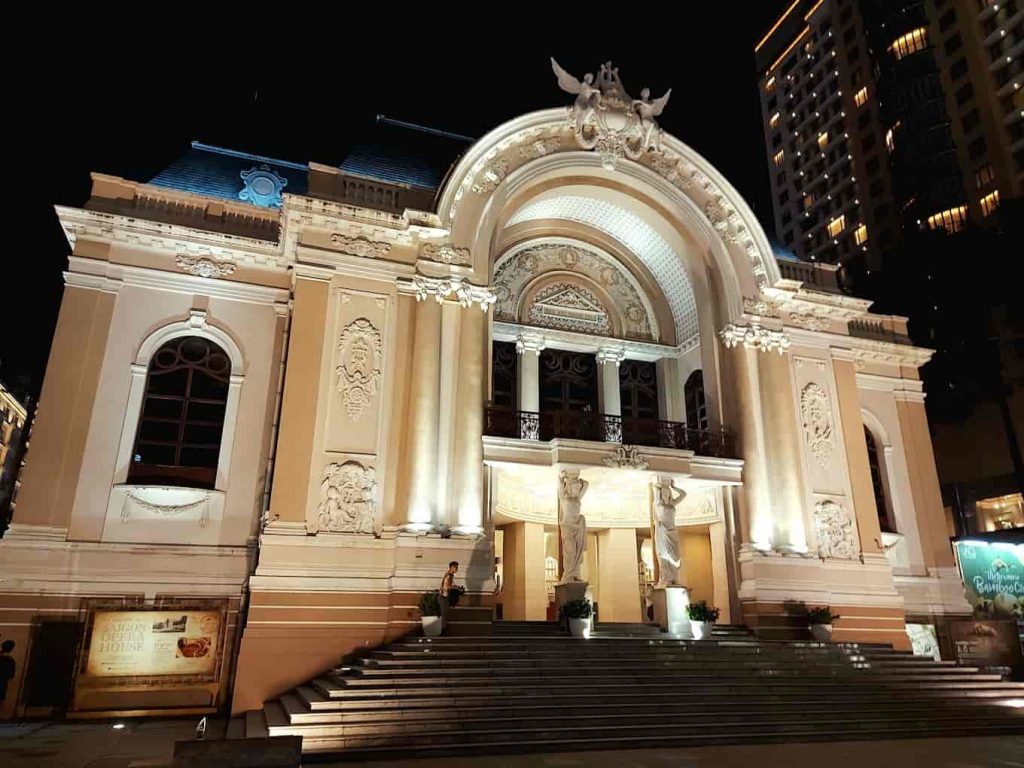
The opera house consists of one ground floor and two upper floors, with a seating capacity of up to 1800. The interior space is as beautiful as a multicolored art museum, adorned with meticulously crafted decorative motifs. The intricately carved dome of the auditorium and the wall-mounted statues are valuable highlights that contribute to its timeless beauty.
Address of the Ho Chi Minh City Opera House
- Address: 7 Lam Son Square, Ben Nghe Ward, District 1
- Opening Hours: Monday – Friday: 9:00 AM – 4:30 PM; Weekends: 9:00 AM – 12:00 PM
The Ho Chi Minh City Opera House is located in the heart of District 1, making it convenient to reach from any starting point. You can choose to go by motorbike or ride-sharing services. If you’re using a personal vehicle, you can park at the City Opera House parking area from 8:00 AM to 10:00 PM. If you prefer to take the bus, you can catch routes numbered 02, 03, 19, 45, or 53.
Furthermore, for convenient transportation and exploring various other locations in the city, you can utilize the private car service with drivers in Ho Chi Minh City from DanangPrivateCar.com. We provide a fleet of new, well-equipped vehicles and have a team of professional drivers with extensive experience serving international travelers. This will ensure you have a comfortable journey. For more details and itinerary planning, you can contact us via email at info@danangprivatecar.com.
How much are tickets for the City Opera House?
The ticket prices for the opera house are not fixed but depend on the specific performance. There are two price ranges for tickets:
- 150,000 – 900,000 VND per ticket for special performances.
- 80,000 – 650,000 VND per ticket for regular performances.
If you wish to visit, tourists can purchase tickets for the performances at the ticket counter or on the theater’s website. After the performance ends, you can walk around to admire the architecture and take check-in photos here.
History of the Formation of the Ho Chi Minh City Opera House
After the French captured Gia Dinh in 1863, they brought the first troupe from the homeland to perform for French officials, officers, and soldiers in Saigon.
Initially, performances were held at the wooden house of naval engineer La Grandière at the Clock Square (Place de l’Horloge) at the corner of Nguyen Du and Dong Khoi streets. These performances mainly featured ballet and opera, sponsored by the Saigon authorities.
However, the cramped space did not meet the growing entertainment needs of the French, so the government decided to build a grand theater. Nevertheless, the cost for this project was significant, and as they had not received a budget from the homeland, the French authorities in Saigon decided to construct a small theater on the land at Catinat Street, next to the planned location for the Grand Theater (which later became the Caravelle Hotel).
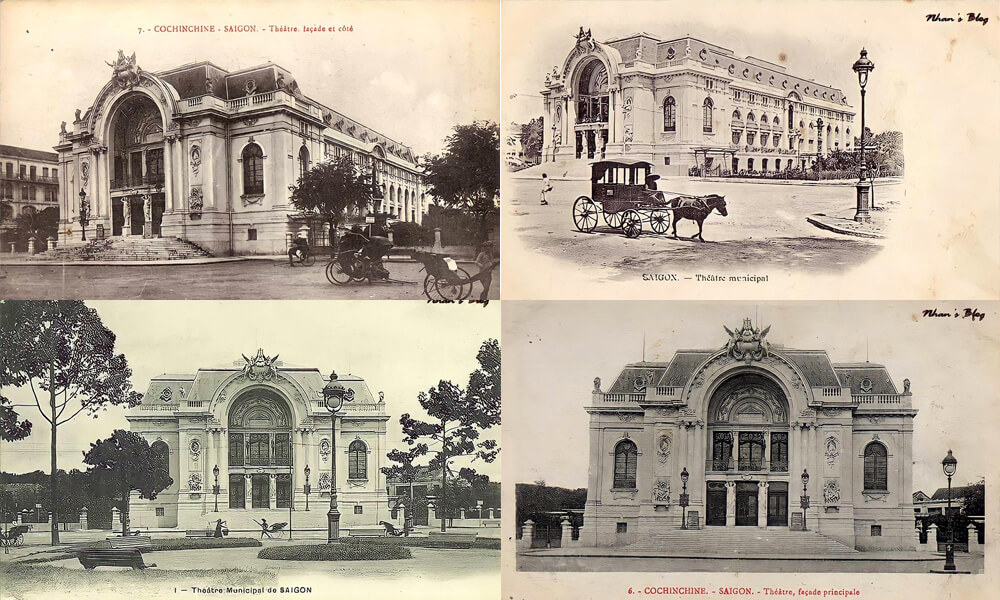
Despite being a project designed to serve the French, it did not receive much support from the French community in Saigon, and there were many objections. They believed the theater was relatively small (with less than 600 seats) and yet very expensive, costing up to 2.5 million francs. Nevertheless, the project proceeded, as Mayor Paul Blanchy believed that a major city like Saigon needed a large theater for cultural activities, befitting its status as the central city of Cochinchina.
It wasn’t until 1898, when funds were secured, that the Opera House construction finally began.
In early 1900, the theater was inaugurated and was referred to by the public as the “Western Theater.” It was the first building constructed by the French in Saigon.
It wasn’t until 1907 that the theater gained credibility. Theater troupes usually came from France and signed contracts with the Saigon authorities under a fixed-term agreement. The theater only performed for about six months during the dry season, starting from October.
In 1918, the government allowed the Opera House to be open to the local population. On November 18, 1918, for the first time, Vietnamese people organized a performance at the Opera House, featuring a combination of traditional theater and reformed opera. However, even the inclusion of Vietnamese programs did not alleviate the lack of audience attendance because “entertainment venues such as nightclubs, restaurants with music and dancing, or cinemas attracted most people, as they were more novel and enticing.”
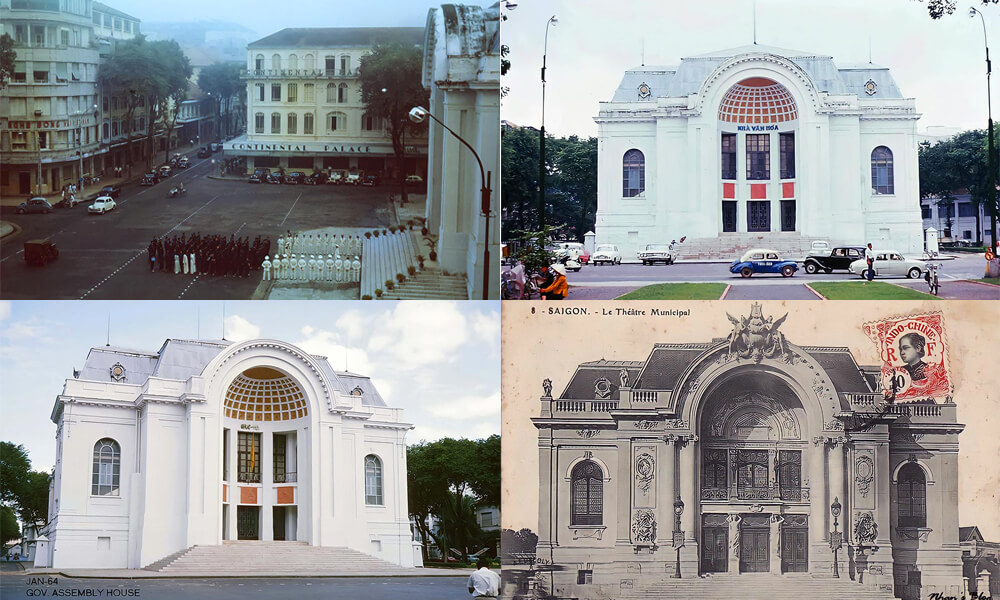
During the period from 1955 to 1975, the city’s theater was primarily used for political purposes. The architectural appearance was modified to suit its new function, with small decorative motifs removed and the round columns dismantled. The architectural style became more straightforward to align with its role as a political meeting place.
After 1975, the theater was returned to its original function of hosting artistic performances.
In 1993, the People’s Committee of Ho Chi Minh City renamed it the Symphony and Chamber Music Hall, later changing it to the Symphony and Opera House. It became a venue dedicated to constructing and organizing classical music programs.
In 1998, after the restoration of the theater, no more political meetings were held there. At this time, the two female statue figures in front of the theater were also restored, returning the theater’s space to its original purpose of artistic performance, no longer suitable for political purposes.
The Opera House used to be the headquarters of the National Assembly
Previously, during the time of the Republic of Vietnam, the City Opera House used to be the assembly hall of the National Assembly and the Senate under the previous regime.
After 1954, the City Opera House was repurposed by the government of the Republic of Vietnam into the National Assembly building during the time of the First Republic and later into the Senate of the Second Republic. In between, it was briefly known as the House of Culture.
The former government renovated the front façade to better align it with its new function, which included the following changes:
- Small decorative motifs were completely removed.
- The ornate patterns on the entrance door were replaced with horizontal stripes resembling a globe.
- The architectural style became more structured to suit the role of a political meeting place.
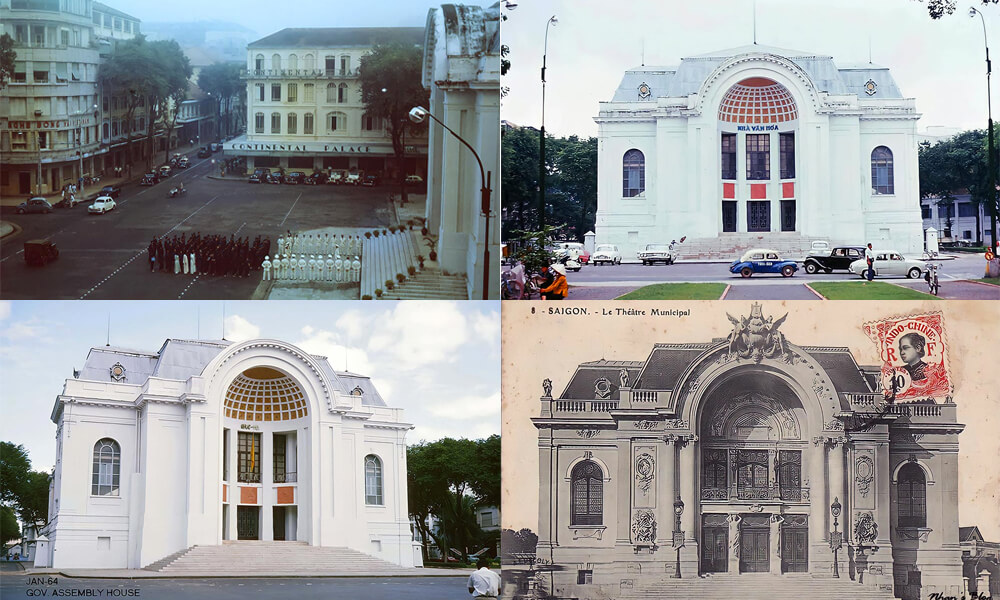
From 1963 to 1967, during the period when the National Assembly was dissolved, the building was referred to as the House of Culture. This was the time when the First Republic was overthrown, the Second Republic had not yet been formed, and South Vietnam was under the leadership of a military council without a National Assembly.
In 1967, when the National Assembly was reestablished with two chambers, similar to many Western countries, the government chose the former National Assembly building (the Opera House) to serve as the Senate’s headquarters and selected the Diên Hồng Hall as the House of Representatives.
After 1975, following the fall of the Saigon government, the Opera House resumed its original function as a venue for artistic performances and was renamed the City Opera House, a role it continues to fulfill to this day.
The unique architecture of the City Opera House
The City Opera House is a remarkable architectural work in Ho Chi Minh City, bearing the prominent Gothic style that was popular in France at the end of the 19th century. The building was designed by a group of French architects, including Félix Olivier, Eugène Ferret, and Ernest Guichard.
It cleverly combines Western architecture with sculptural art, with sculpture as the primary decorative element. From the exterior to the interior, the building is adorned with numerous bas-reliefs and statues.

The many ornate bas-reliefs and motifs, along with the two statues of goddesses in front of the entrance in the Renaissance style, enhance the ancient beauty of the City Opera House.
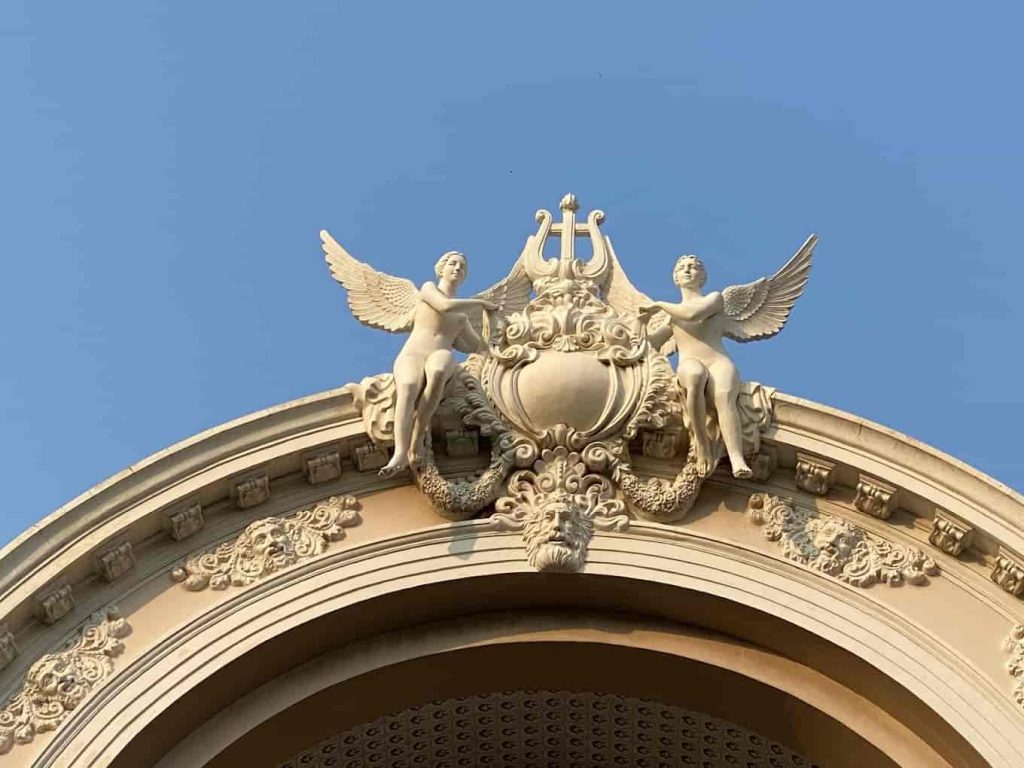
The interior of the opera house is fully equipped with a sound and lighting system. In addition to the ground floor, there are two upper floors, providing seating for up to 1,800 people.
The system of arched doors with tall balconies is designed in the classical French architectural style of that era, making the City Opera House undoubtedly more elegant in the eyes of tourists.
The ART NOUVEAU Mural
The City Opera House exhibits the characteristics of the architectural style of the Second French Colonial Empire period, an era known for its incorporation of various European historical styles, including Baroque.

When inspecting the paintings in the opera house, we can observe significant similarities with the “The Seasons” series by Alphonse Mucha (1860 – 1939). He was a prominent artist of the Art Nouveau movement with a far-reaching influence on many subsequent decorative artists. It’s likely that during the selection of the decorative project for the City Opera House, the artists directly referenced Mucha’s works and adapted them into these paintings.

Art Performances at Ho Chi Minh City Opera House
True to its name, the City Opera House serves as a stage for a wide variety of performances, from opera and chamber music to various forms of dance, musicals, and more. Renowned artists from around the world often choose this venue for their international tours. If you plan to attend a performance at the City Opera House, here are some outstanding shows to consider:
A O Show
This unique performance combines various art forms such as acrobatics, bamboo cirque, contemporary dance, and traditional music. Lasting for an hour, the show vividly portrays the contrast between the graceful and rich rural life and the urbanization of the modern era. The rapid succession of powerful emotions will make the 60 minutes fly by, and you might even find yourself repeatedly saying “A” and “O” in amazement!
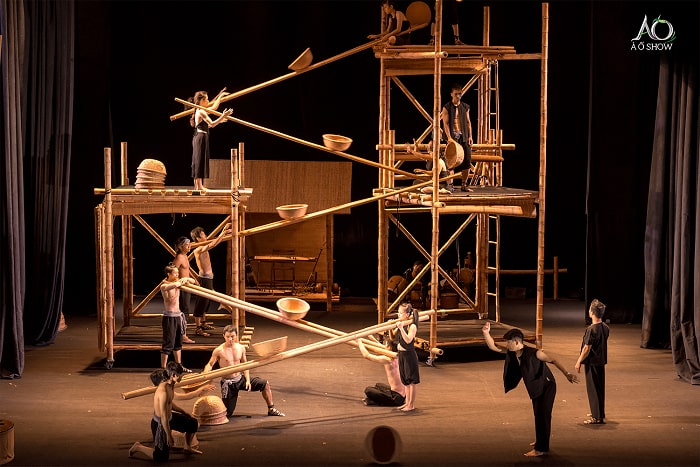
Teh Dar
Teh Dar promises to be full of surprises. You’ll step into the world of mysterious and pristine stories of the highland people of Vietnam. The performance includes daring acrobatics set to the music of traditional instruments, as well as stunning Bamboo Cirque acts.

The Mist
Another beloved show with a poetic name, “The Mist,” takes you on a journey with classical and modern dance artists into the life of Southern Vietnamese farmers. Condensing various aspects of life, from the misty morning to the harvest season, this show captures the unyielding willpower and dedication of the farmers using lively music, captivating lighting effects, and grand special effects. You’ll also fall in love with the traditional Vietnamese costumes like bamboo clogs, ao ba ba, ao dai, and ao tu than as they appear in the show more beautiful than ever.
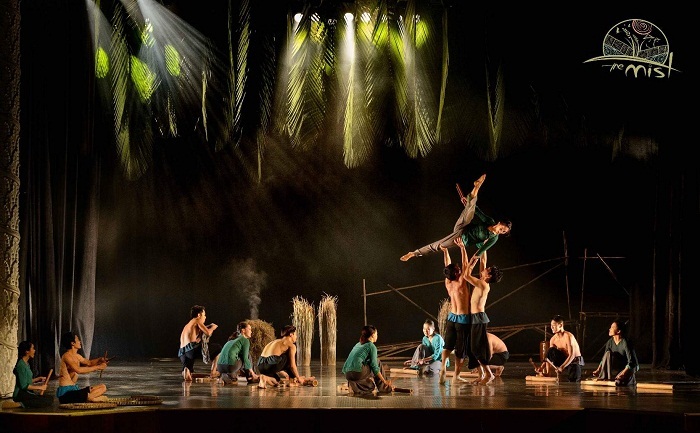
Opera Gala Symphony Nights
The Saigon Opera House is still an interesting destination for tourists who don’t know where to go in Saigon at night. Here, they regularly organize symphony concerts by famous composers such as Mozart, Bach, Beethoven, and more.
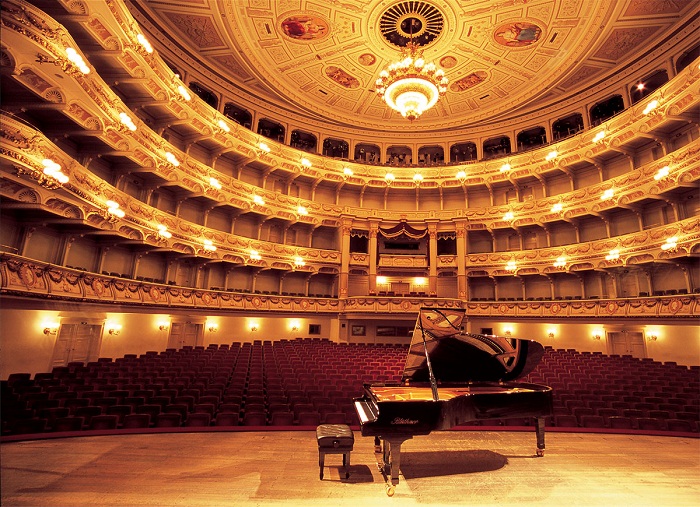
Other Programs
Ho Chi Minh City Opera House also hosts many Vietnamese pop music concerts and symphonic concerts by great composers like Mozart, Beethoven, Bach, and more. While sitting in the opera house, listening to the chamber music, you’ll feel like you’ve stepped into the life of nobility from ancient times and indulge in the pinnacle of art.
Famous Sightseeing Spots Near the Ho Chi Minh City Opera House
After visiting the Ho Chi Minh City Opera House, if you’re looking for more famous sightseeing spots nearby, here are some suggestions provided by DanangPrivateCar.com’s:
Nguyen Hue Walking Street
Located just a 5-minute walk from the Opera House, Nguyen Hue Walking Street is an ideal place for photos, especially for young people and tourists. With its spacious layout and beautiful arrangements, including a statue of Ho Chi Minh, water fountains, flagpole, and unique landscapes, this pedestrian street provides a backdrop for impressive and captivating photos. Most people visit in the late afternoon or evening to take pictures and enjoy the open atmosphere.
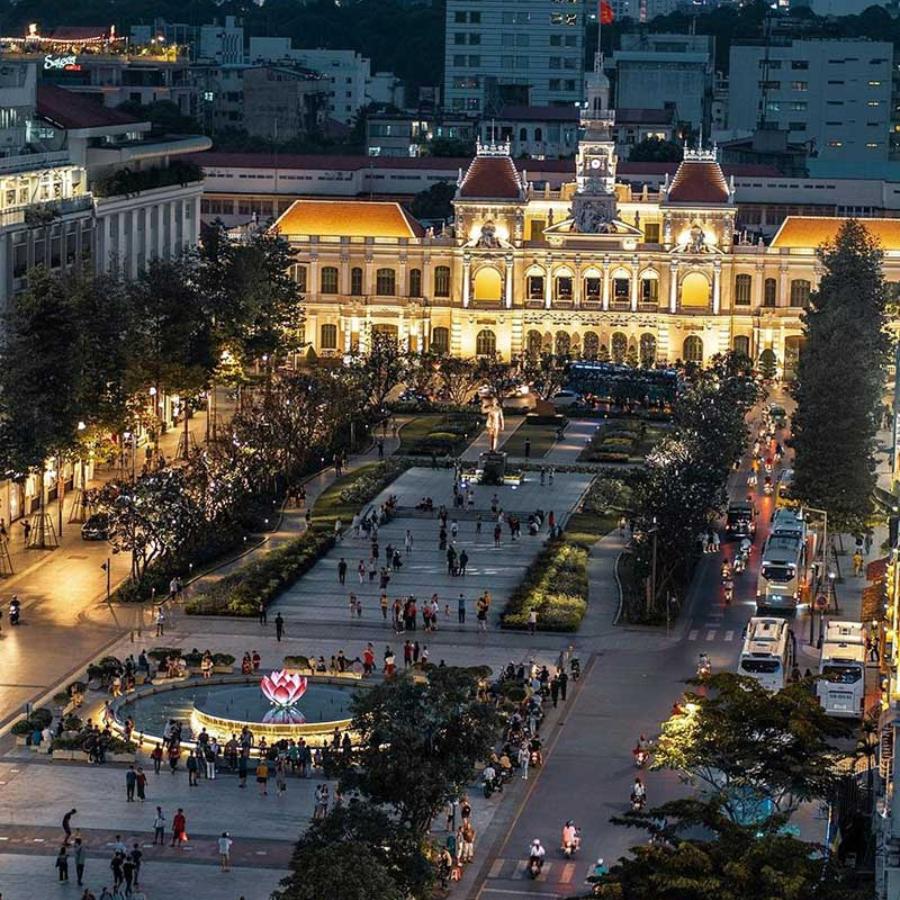
Notre-Dame Cathedral of Saigon
Notre-Dame Cathedral of Saigon A short stroll from the opera house, this iconic cathedral with its unique red brick facade stands out against the modern cityscape. It’s a tranquil place to visit, offering a contrast to the bustling streets of Saigon.
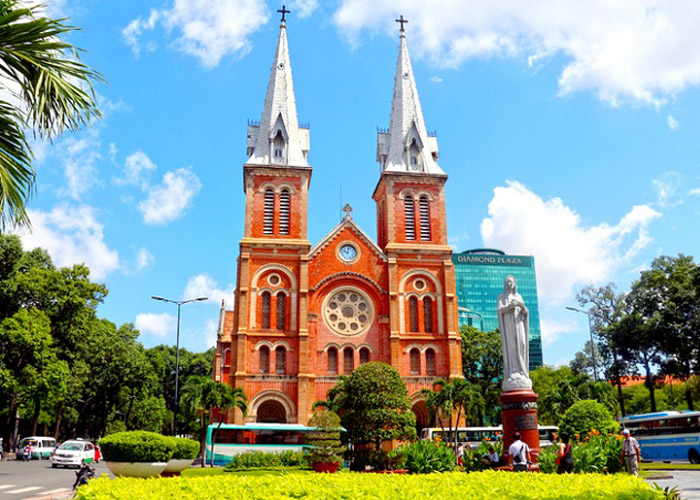
Saigon Central Post Office
Right next to the cathedral is the Saigon Central Post Office in Ho Chi Minh City, designed by the famous Gustave Eiffel, the same architect behind the Eiffel Tower in Paris. This historical post office is a testament to French colonial architecture and is not only functional but also visually stunning.
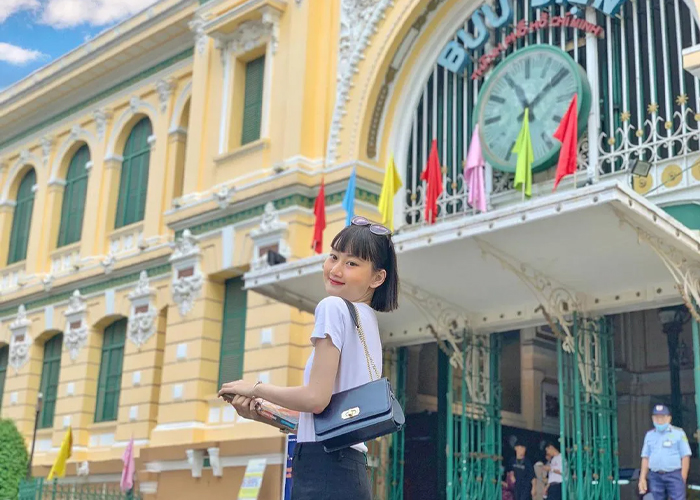
Ben Thanh Market
Located in the list of famous must-visit destinations when traveling to Ho Chi Minh City, Ben Thanh Market is an essential piece in the lively and vibrant picture of the city named after Uncle Ho.
With its outstanding European architecture in the city center and numerous photo spots, this market attracts a large number of tourists every day who come to check in and shop.

Things to Note When Visiting the City Opera House
- Purchase your tickets in advance and arrive at least 15-30 minutes before the performance to secure your seats. You can arrive even earlier if you want to take check-in photos or explore the opera house.
- Bring a good camera or a “photographer” to take pictures with the artists after the show.
- Avoid bringing food or scented beverages as they can affect the atmosphere and the experience of those around you.
- Dress elegantly and neatly, and avoid wearing provocative clothing.
Whether you are a fan of the arts or not, the Ho Chi Minh City Opera House is a remarkable destination you shouldn’t miss during your visit to Ho Chi Minh City. These are the pieces of information that DanangPrivateCar.com has shared with you, wishing you and your loved ones a delightful experience at the Ho Chi Minh City Opera House.

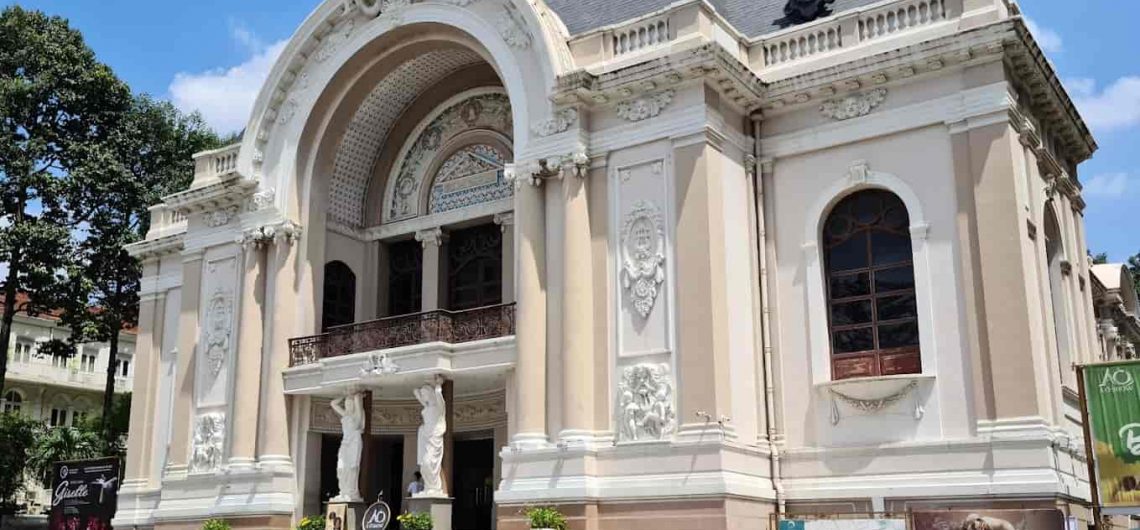
Comments